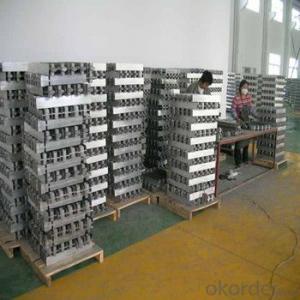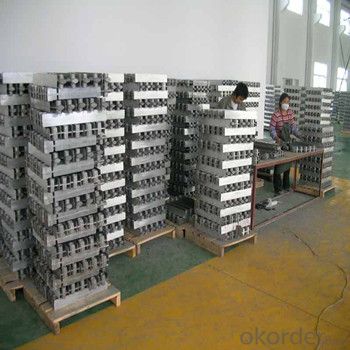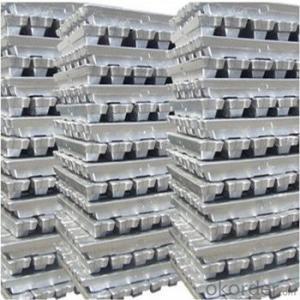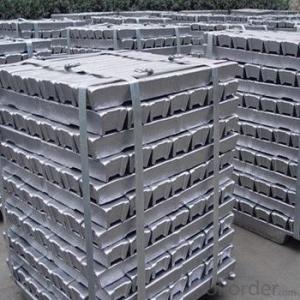Aluminum Pig/Ingot With Good Quality And Wholesale Price
- Loading Port:
- China main port
- Payment Terms:
- TT OR LC
- Min Order Qty:
- 1000 m.t.
- Supply Capability:
- 100000 m.t./month
OKorder Service Pledge
OKorder Financial Service
You Might Also Like
Pure Aluminum Pig/Ingot Used for Industry
1.Structure of Aluminum Pig/Ingot
A material that has been cast into a shape in order to be transported and processed easier than in an unprocessed form. An ingot is typically rectangular in shape, which allows it to be stacked. Ingots are most commonly associated with metals, with ingots of gold held in the vaults of banks and brokerages being popular images.
Aluminum Ingot is with the AL as the main chemical composition.Aluminum Ingot is used for industry,such as automobile,pinning and weaving,electron broadly and so on. Aluminum Ingot has the following advantages: easy control and operation, fast melting.
2.Main Features of the Aluminum Pig/Ingot
•High Purity
•Easy control and operation
•High strength
•Fast melting
•Competitive price
•Best Service
3.Aluminum Pig/Ingot Images

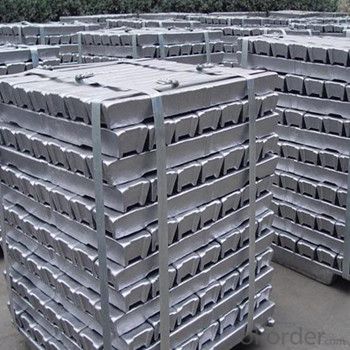
4.Aluminum Pig/Ingot Specification
Grade | Chemical Composition % | |||||||||
Al≥ | impurities ≤ | |||||||||
Si | Fe | Cu | Ga | Mg | Zn | Mn | others | Sum | ||
Al99.9 | 99.90 | 0.50 | 0.07 | 0.005 | 0.02 | 0.01 | 0.025 | - | 0.010 | 0.10 |
Al99.85 | 99.85 | 0.80 | 0.12 | 0.005 | 0.03 | 0.02 | 0.030 | - | 0.015 | 0.15 |
Al99.7 | 99.70 | 0.10 | 0.20 | 0.010 | 0.03 | 0.02 | 0.030 | - | 0.030 | 0.30 |
Al99.6 | 99.60 | 0.16 | 0.25 | 0.010 | 0.03 | 0.03 | 0.030 | - | 0.030 | 0.40 |
Al99.5 | 99.50 | 0.22 | 0.30 | 0.020 | 0.03 | 0.05 | 0.050 | - | 0.030 | 0.50 |
Al99.00 | 99.00 | 0.42 | 0.50 | 0.020 | 0.03 | 0.05 | 0.050 | - | 0.050 | 1.00 |
5.FAQ of Aluminum Pig/Ingot
We have organized several common questions for our clients,may help you sincerely:
①How about your company?
A professional manufacturers of the alumiun pig.Devoted in this industry for many years,so got much experice.The quality and service have also accepted by customer.Can meet customers' requiements to provide different grade and purity alumiun pig.
②How to guarantee the quality of the products?
We have established the international advanced quality management system,every link from raw material to final product we have strict quality test;We resolutely put an end to unqualified products flowing into the market. At the same time, we will provide necessary follow-up service assurance.
③How long can we receive the prod rking days, We will arrange the factory delivery as soon as possible. The pecific time of receiving is related to the state and position of customers.Commonly 7 to 10 working days can be served.
- Q: How are aluminum ingots used in the production of signage?
- The lightweight, durable, and versatile nature of aluminum ingots makes them crucial in the production of signage. When creating signage, aluminum ingots are melted and then turned into various sign components or sheets, depending on the desired design and purpose. One of the primary uses of aluminum ingots in signage production is for crafting sign frames. These frames provide structural support and stability to the signage, ensuring its longevity and resistance to weather conditions. Aluminum's lightweight nature makes it easier to transport, install, and maintain these sign frames. Furthermore, aluminum ingots are commonly utilized in creating sign panels or sheets. These panels can be cut, drilled, or shaped into different sizes and designs, allowing for customization and creativity in signage production. The durability of aluminum guarantees that these panels can endure outdoor exposure and remain intact for long periods. Moreover, aluminum ingots are employed in producing sign letters or logos. Signage made from aluminum letters provides a professional and sleek appearance that can enhance the overall aesthetic appeal of the signage. By using aluminum ingots, sign manufacturers can effortlessly create precise and intricate lettering. Additionally, aluminum ingots offer excellent corrosion resistance, making them ideal for outdoor signage applications. They can withstand harsh weather conditions, UV exposure, and temperature variations without deteriorating or losing their visual appeal. This makes aluminum an optimal material for outdoor signs where durability and longevity are crucial. In conclusion, the lightweight, durable, and versatile nature of aluminum ingots makes them widely used in signage production. They are transformed into sign frames, panels, and letters, providing structural support, customization options, and a professional appearance. With their corrosion resistance, aluminum ingots ensure that signage remains intact and visually appealing even in challenging outdoor environments.
- Q: How are aluminum ingots used in the production of medical implants?
- Aluminum ingots are used in the production of medical implants in several ways. Firstly, aluminum ingots are melted down and cast into specific shapes and sizes to create the base structure of the medical implant. This process allows for the customization of the implant to fit the patient's specific needs. Once the aluminum ingots are cast into the desired shape, they are further processed to enhance their properties. This may involve heat treatment, forging, or machining to improve the mechanical strength, durability, and biocompatibility of the implant. Aluminum ingots can be easily manipulated to achieve the desired mechanical properties, making them suitable for various implant applications. Moreover, aluminum ingots are often coated with biocompatible materials to improve their performance as medical implants. These coatings can enhance the implant's corrosion resistance, reduce wear and tear, and promote osseointegration (the connection between the implant and the patient's bone). Additionally, aluminum ingots are lightweight, which is advantageous for medical implants as it reduces the overall burden on the patient's body. This is particularly beneficial for implants that are used in load-bearing applications, such as hip or knee replacements. Overall, aluminum ingots play a crucial role in the production of medical implants by providing a versatile, customizable, and lightweight material that can be processed and coated to meet the specific requirements of each patient.
- Q: Production process of aluminium ingot
- The production of aluminum ingot is made up of bauxite mining, alumina production, aluminum electrolysis and other production links.First a bauxite mining, water washing, grinding and other processes to produce aluminum powder, alumina roasting by complex processes such as four by bauxite alumina production, there are three main types: gibbsite and diaspore, boehmite.
- Q: How is the purity of aluminum ingots determined?
- The purity of aluminum ingots is determined through various analytical techniques and testing methods. One common method used is spectroscopy, specifically inductively coupled plasma optical emission spectroscopy (ICP-OES) or inductively coupled plasma mass spectrometry (ICP-MS). These techniques are capable of analyzing the elemental composition of the aluminum ingot, including the presence of impurities such as iron, silicon, copper, zinc, and others. Another technique employed is atomic absorption spectroscopy (AAS), which focuses on measuring the concentration of specific elements in the aluminum ingot. This method allows for the detection of trace impurities, as it is highly sensitive and selective for individual elements. Chemical analysis is also utilized to determine the purity of aluminum ingots. Acid digestion methods, such as dissolution in nitric acid or hydrochloric acid, are commonly used to dissolve the ingot and create a solution that can be analyzed for impurities. The resulting solution is then subjected to various tests, including titration, colorimetry, or gravimetric analysis, to quantify the impurities present. In addition to these techniques, physical testing methods can be employed to evaluate the purity of aluminum ingots. These methods involve measuring the physical properties of the ingot, such as density, melting point, or electrical conductivity. Deviations from the expected values can indicate the presence of impurities. Overall, determining the purity of aluminum ingots involves a combination of spectroscopic, chemical, and physical analysis techniques, allowing for a comprehensive assessment of the elemental composition and impurity levels in the ingot sample.
- Q: What are the advantages of the CNC process for aluminum and die cast aluminum?
- Aluminum profiles are widely used in furniture: screen frames, all kinds of hanging beams, tables, feet, decorative strips, handles, winding grooves and covers, chairs, tubes, etc., can be ever-changing design and use!
- Q: Does aluminum ingots produced without aluminum ore belong to metal smelting?
- Smelting principle1. reduction method: metal oxides (together with reducing agents) - free metals2., replacement method: metal salt solution (add active metal) - free metal3. electrolysis: molten metal salts (electrolysis) - - free metals (metal elements)
- Q: What are the main factors influencing the choice between aluminum ingots and aluminum forgings?
- Several factors need to be taken into account when deciding between aluminum ingots and aluminum forgings. 1. The complexity of the desired design is a crucial factor in determining which option to choose. If the design requires complex shapes or intricate designs, forgings are generally preferred. They have the ability to be shaped into specific forms with minimal internal defects, making them suitable in such cases. 2. The mechanical properties required for the end product also influence the choice. Forgings are known to have superior mechanical properties compared to ingots, such as higher strength, better fatigue resistance, and improved impact toughness. Therefore, if high mechanical performance is necessary, forgings might be the preferred option. 3. Material waste is another consideration. Aluminum ingots are typically machined from large quantities of material, generating a significant amount of waste. On the other hand, aluminum forgings are produced through a forging process that minimizes material waste. So, if waste reduction is a concern, forgings could be a more environmentally friendly choice. 4. Cost is an important factor to consider. Aluminum forgings often involve additional manufacturing steps, which can increase the overall cost. In contrast, aluminum ingots may require less processing, making them a more cost-effective option in some cases. 5. The required production volume also plays a role. Aluminum ingots are better suited for high-volume production due to their ability to be easily cast into various shapes. Aluminum forgings, on the other hand, are more commonly used for low to medium volume production, as the forging process is more time-consuming and costly for large-scale production. In conclusion, the choice between aluminum ingots and aluminum forgings is influenced by factors such as design complexity, mechanical properties, material waste, cost considerations, and production volume. Carefully considering these factors will help determine the most suitable option for a given application.
- Q: Process description of aluminium ingot
- The casting process of aluminum ingot is molten aluminum liquid into the mold. When the billet is cooled and cast out, the injection process is the key step of the product. The casting process is the physical process of liquid aluminum being crystallized into solid aluminum. The technological process of casting aluminium ingots is as follows:Aluminum - slag - weighing batching furnace - refining - casting - Remelting aluminum ingot - finished product inspection, weighing and warehousingAluminum - slag - weighing batching furnace - scouring - casting alloy ingot casting alloy ingot - - - - - storage of finished product inspection work
- Q: What is the difference between a aluminium ingot with and without a ticket?
- Beijing's purchase price is the price of aluminum, aluminum ingot + processing fees, billing is generally not a ton of processing fee will be about 400 yuan less, your price is overall, the overall profits can be, I think do not have to manage open ballot problem of aluminum ingots.
- Q: What are the advantages of using aluminum ingots in aerospace applications?
- Using aluminum ingots in aerospace applications has several advantages: 1. Lightweight: Aluminum is a lightweight material, which is crucial in aerospace applications where reducing weight is important. This allows for better fuel efficiency and increased payload capacity, resulting in improved aircraft performance. 2. Strength: Despite being lightweight, aluminum ingots have an excellent strength-to-weight ratio. They can withstand high stresses and loads, providing structural integrity and durability to aerospace components. This strength is essential for ensuring the safety and reliability of aircraft structures. 3. Corrosion resistance: Aluminum ingots have inherent corrosion resistance because they form a protective oxide layer. This is particularly significant in aerospace applications as aircraft often face harsh environmental conditions such as humidity, saltwater, and extreme temperatures. Aluminum's corrosion resistance helps prolong the lifespan of aerospace components and reduces maintenance needs. 4. Formability: Aluminum ingots are highly malleable, making it easy to shape and form them into complex structures. This flexibility in manufacturing processes allows designers to create intricate and aerodynamic components, leading to improved efficiency and performance of the aircraft. 5. Thermal conductivity: Aluminum has excellent thermal conductivity, meaning it can effectively transfer and dissipate heat. In aerospace applications, this is particularly valuable as it helps manage and regulate the temperature within the aircraft. It prevents critical components from overheating and ensures optimal performance. 6. Recyclability: Aluminum is highly recyclable, and ingots made from recycled aluminum can be used in aerospace applications. This not only reduces the environmental impact of manufacturing but also provides cost savings. Recycled aluminum ingots offer similar performance characteristics as virgin aluminum, making them a sustainable and economically viable choice for the aerospace industry. Overall, the advantages of using aluminum ingots in aerospace applications make it the preferred material for various components, including fuselages, wings, and structural elements. Its lightweight, strength, corrosion resistance, formability, thermal conductivity, and recyclability properties contribute to improved aircraft performance, safety, and sustainability.
Send your message to us
Aluminum Pig/Ingot With Good Quality And Wholesale Price
- Loading Port:
- China main port
- Payment Terms:
- TT OR LC
- Min Order Qty:
- 1000 m.t.
- Supply Capability:
- 100000 m.t./month
OKorder Service Pledge
OKorder Financial Service
Similar products
Hot products
Hot Searches
